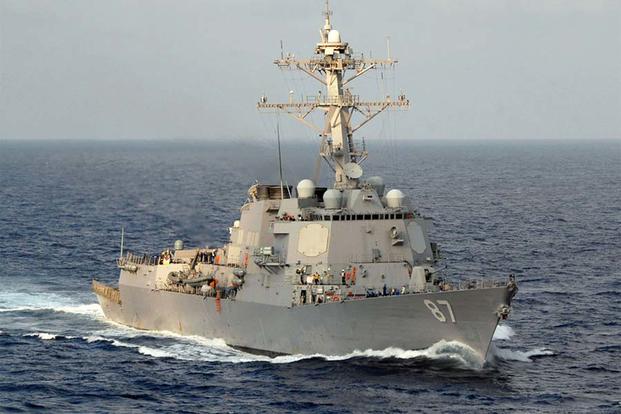When missiles launched from the coast of Yemen targeted multiple ships in Carrier Strike Group 10 in October, crews had to use precision and speed to execute defenses, including a retaliatory strike Oct 12 that destroyed radar sites where the missiles were believed to have originated.
But the response to at least two separate incidents was part of the workday for sailors as they operated the vessels in international waters, said Rear Adm. James Malloy, commander of the carrier strike group.
"They defended themselves as they are trained to do, as the ships are capable of doing," Malloy told Military.com in a phone interview from the carrier Dwight D. Eisenhower, now operating in the Arabian Gulf.
"They operated in accordance with training, and their equipment worked as it was designed to do," he said. "So, continue to do the job and be prepared to handle any contingency out here, that was my only guidance after that episode."
The guided-missile destroyer Mason was first to come under attack, defending itself against two missiles fired from a portion of the Yemen coast controlled by Iran-backed Houthi rebels. The ship, which had been patrolling near the Bab Al-Mandab Strait between Yemen and the Horn of Africa, used countermeasures including Standard Missile-2s and a SeaSparrow missile to intercept the missiles and a Nulka decoy to direct it away from the ship.
Another pair of missiles were fired at the Mason Oct. 12 from the same region on the coast of Yemen. The same day, the guided-missile destroyer Nitze, operating nearby, struck and destroyed three radar sites using Tomahawk missiles.
Both the Nitze and the Mason are part of the 10th Carrier Strike Group. Malloy emphasized that the ships stayed put in the region, continuing patrols as part of their scheduled deployment.
"We continue to operate where we operate at the fore, in support of partners in the region and ensuring free flow of commerce through this critical region," he said. "It's one of the main reasons we're out here, and we're continuing that business today."
Some ambiguity continues to surround reports of a third attack, however. On Oct. 16, officials including Chief of Naval Operations Adm. John Richardson said the Mason appeared to have been targeted by missiles yet again. These reports were later walked back by Pentagon officials, who said the incident and the response by the Mason remained under investigation.
Malloy said officials continued to look into the incident. He also suggested that the Mason had deployed missile countermeasures in response to the suspected attack, a factor also being investigated.
"The Aegis system that these ships field has the capability to do recording much like aircraft do," he said. "All three of those events are being looked at, to see what occurred and also to ensure that our systems are operating at their full capability, which we think that they were. When any instance happens that ammunition is expended like that against a threat, we're about process improvement wherever we can look at it, and that's being looked at right now."
The conclusions of the review would likely be announced by Richardson when they were complete, Malloy said.
-- Hope Hodge Seck can be reached at hope.seck@military.com. Follow her on Twitter at @HopeSeck.





























